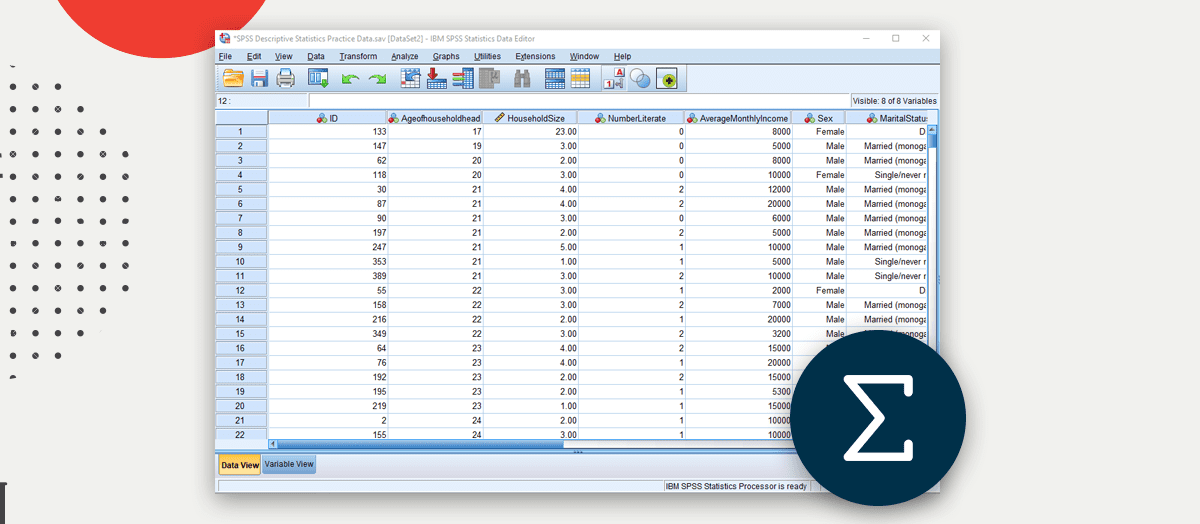
From the menu, click on Transform -> Compute Variable… -> specify new target variable name, mv_outlier, in Target Variable: -> add 0 in Numeric Expression: -> Hit Continue and then hit Paste. Move any continuous variable to Dependent: and all relevant variables to Independent(s): -> hit Save… -> check Mahalanobis -> Hit continue and paste. In SPSS, Analyze -> Regression -> Linear. Check the case with Mah > chi-square cut-off with a degree of freedom of #Variables + 1. No estimates, standard errors or tests for this regression are of any interest, only the individual Mah scores. Ask Mahalanobis distance to be saved as an additional variable in the original data set. (May use subject ID as the DV in this regression.) Regress a variable of no interest upon all variables (DVs and IVs, treated here as ‘predictors’) that will be of concern in an analytic session. #Spss descriptive statistics how to
How to compute Mahalanobis distance in SPSS? In the appearance window, move all four variables to the Variable(s): and check save standardized values as variables.
 In SPSS, Analyze -> Descriptive Statistics -> Descriptives. Univariate outliers are ones with the associated z scores higher than 3 or smaller than -3. Outlier is a case with such an extreme value on one variable (univariate outlier), or such an abnormal combination of values on several variables (multivariate outlier), which may make it very influential for data analysis results. You can also get the same results by using the syntax (below): Based on Shapiro-Wilk Petal.Length and Petal.Width variables are significant p<.001 indicating that they have issues with normality while Sepal.Length and Sepal.Width are non-significant. Based on Kolmogorov-Smirnov, all variables are significant p<.001 except for Sepal.Length p=.006. We want the test of normality to be insignificant. In SPSS, Analyze -> Explore -> Plot… -> Check Histogram under Descriptive -> Check Normality plots with tests. Frequency : Analyze -> Descriptive Statistics -> Frequencies…. In SPSS, Descriptive Stats: Analyze -> Descriptive Statistics -> Descriptives…. VARIABLES=Sepal.Length Sepal.Width Petal.Length Petal.Widthįrom the above table, we could extract R, S, Q matrices and describe the pattern of relationship among variables. Or you could do it by writing the syntax (below): Analyze → Correlate → Bivariate → Move variables of interest to Variables -> Options → select “Cross-product deviations and covariances”. It could be raw data, or covariance matrix (S), or correlation matrix (R), or sum-of-square and cross-product (SSCP, Q). it is no firm guideline ) are missing in a random pattern, the problems are less serious.įirst, you should get a dataset for Multivariate Statistics (MVS). If only a few data points (5% or less – note.
In SPSS, Analyze -> Descriptive Statistics -> Descriptives. Univariate outliers are ones with the associated z scores higher than 3 or smaller than -3. Outlier is a case with such an extreme value on one variable (univariate outlier), or such an abnormal combination of values on several variables (multivariate outlier), which may make it very influential for data analysis results. You can also get the same results by using the syntax (below): Based on Shapiro-Wilk Petal.Length and Petal.Width variables are significant p<.001 indicating that they have issues with normality while Sepal.Length and Sepal.Width are non-significant. Based on Kolmogorov-Smirnov, all variables are significant p<.001 except for Sepal.Length p=.006. We want the test of normality to be insignificant. In SPSS, Analyze -> Explore -> Plot… -> Check Histogram under Descriptive -> Check Normality plots with tests. Frequency : Analyze -> Descriptive Statistics -> Frequencies…. In SPSS, Descriptive Stats: Analyze -> Descriptive Statistics -> Descriptives…. VARIABLES=Sepal.Length Sepal.Width Petal.Length Petal.Widthįrom the above table, we could extract R, S, Q matrices and describe the pattern of relationship among variables. Or you could do it by writing the syntax (below): Analyze → Correlate → Bivariate → Move variables of interest to Variables -> Options → select “Cross-product deviations and covariances”. It could be raw data, or covariance matrix (S), or correlation matrix (R), or sum-of-square and cross-product (SSCP, Q). it is no firm guideline ) are missing in a random pattern, the problems are less serious.įirst, you should get a dataset for Multivariate Statistics (MVS). If only a few data points (5% or less – note. 
Handle missing data – missing pattern is more important than the amount missing.The multicollinearity and singularity – perfect or near perfect correlations among variables – can threaten a multivariate analysis.
 The outliers – cases that are extreme – that can distort results from MVS analysis. The underlying assumptions are met or not. The accuracy of the data by examining descriptive statistics.
The outliers – cases that are extreme – that can distort results from MVS analysis. The underlying assumptions are met or not. The accuracy of the data by examining descriptive statistics. 
We have to run a data screening by checking the following:








 0 kommentar(er)
0 kommentar(er)
